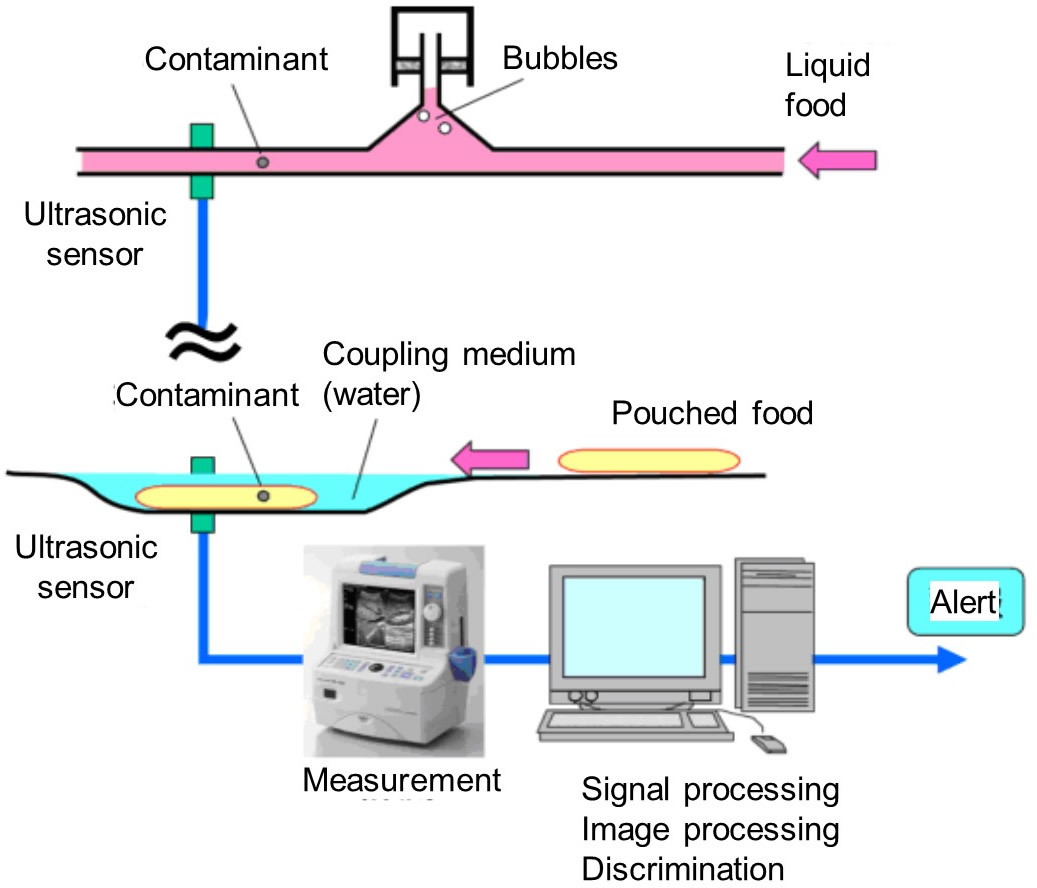
ここからコンテンツです。

Food contaminant detector using Ultrasound
By Naohiro Hozumi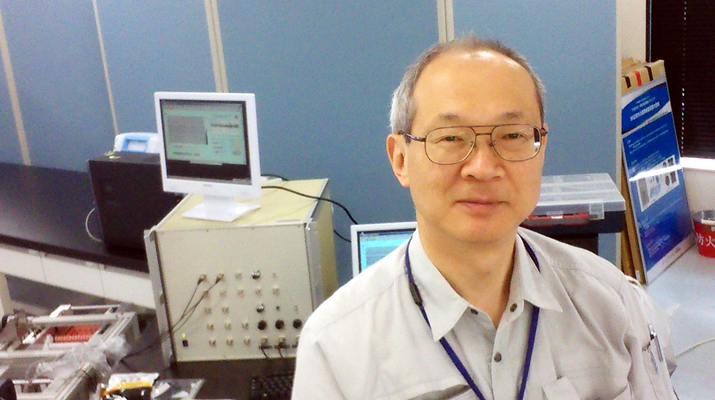
Ultrasound propagation is influenced by acoustic transparency, hardness, and scatter. By applying ultrasound imaging technology, a food contaminant detector is being developed. It has the potential to detect non-metallic contaminants like hairs and plastics that are not easily detected by conventional systems using optical and electromagnetic measures.
Contamination is a serious issue in the food industry. Electromagnetic measures can barely detect non-metallic solid contaminants such as hair and plastics. As in many cases the food is not transparent, which makes optical detection difficult. Ultrasound can reach relatively deep within the target, although its spatial resolution is not as good as optical observation. It is expected that ultrasound can be used to detect certain solid contaminants that would not otherwise easily be detected.
Ultrasound, which has a much higher frequency than audible sound, is subjected to a significant attenuation in air. Therefore coupling to the target must be done through some liquid medium like water. Also the target food must be in the condition of a liquid, paste, or airless solid. Liquid state food like milk may be inspected by coupling a sensor to the flow path like a pipe. Pouch packed food, which normally does not include a significant amount of air, may be transparent to ultrasound. Although the pouch film is often made of aluminum laminate, its lack of thickness means that in practice it can be easily penetrated by ultrasound up to 10 MHz. Therefore contaminants in such food pouches may be detected although coupling to the sensor must be retained by water. The potential for contaminant detection would be upgraded then if ultrasonic detection were added to the system, as optical and electromagnetic measures may be inadequate for detection through aluminum film.
Food processing lines routinely run as fast as 20 m/s. The detection system should be quick enough to follow the processing speed. In the case of reflection type detection using equipment similar to the medical B-mode inspector, the sensor transmits and receives ultrasound one line at a time. If the number of array elements is 128, 128 separate line scans are required to create one B-mode image. So the number of frames produced in one second may be as low as 60.
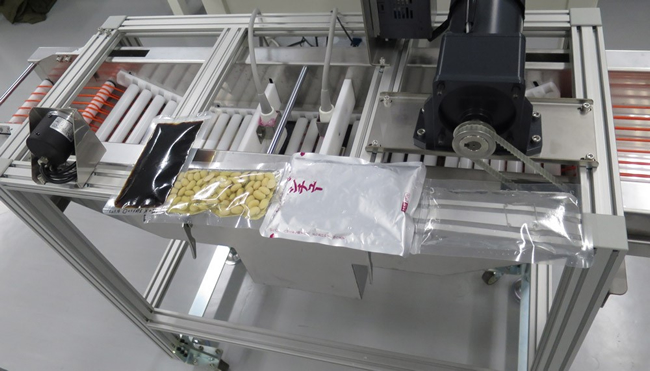
On the other hand if a transmission mode requiring a single one way trip thorough the target is employed, one shot of ultrasound can be received simultaneously by array sensors.
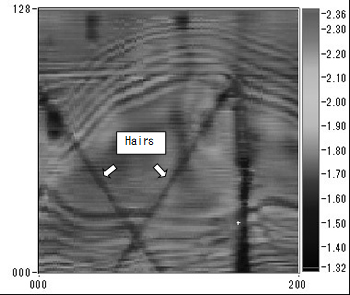
This process can realize extremely high speed detection. In the project, a prototype was created by using an array sensor composed of 512 elements. One shot of ultrasound can create 512 pixels in the image. A transmission image can be created when the target moves across the sensor.
The picture represents two hairs arranged diagonally in a rectangular wire frame that was placed in water in an aluminum laminated pouch film. The hairs can clearly be seen, suggesting the potential of detection under ideal conditions. As the ultrasonic beam is not focused, the image of the hairs is somewhat blurred. However the image may be improved if an acoustic lens using something like acrilic resin is employed. Discrimination between contaminants and solid ingredients may be realized based on the difference in transparency. Therefore it can be expected that this method will prove useful when applied to the safety control of real food.
Reference
穂積直裕,神納貴生,遠藤政男,伊藤智啓,市毛将司,小林和人,天野啓二, 「超音波による食品中の異物検査の基礎検討」、超音波TECHNO, Vol. 28, No. 2 pp. 85-90 (2016)
超音波を利用した食品中の異物検査装置の開発
超音波の透過性及び硬さや散乱に対する情報の取得性等の性質を利用した超音波診断技術を応用し、現状の異物検査装置では困難なレトルト食品内などの異物(毛髪、プラスチック等)の検出を可能にする超音波イメージング異物検査装置を開発しました。
食品に固形の非金属異物(毛髪、プラスチック等)が混入している場合は、磁気や電磁波を使った検出が難しく、食品が不透明であることが多いことから、光による方法にも限界があります。超音波は、空間分解能は高くないものの比較的深部まで透過し、硬さや散乱に関する情報が得られるため、他の手法で検出困難な固形物の検出が可能と期待されます。
超音波は可聴域の音波と異なり、空気中での減衰が大きいため、センサ部(プローブ振動子)と食品が水等を介して、音響的に接触する必要があります。従って、異物検出の可能性がある食品は液状、ペースト状、空気を含まない固形のものです。牛乳などの液体流動食品は、流路にセンサを取り付けて音響的結合が可能と考えられます。レトルト食品は、ほとんど空気を含まないため、内部は超音波を通しやすいのです。レトルト用包装フィルムは保存性を高めるため多くの場合アルミを含みますが、非常に薄いので、10 MHz程度までの超音波は比較的良好に透過することができます。センサ部との間に水などの音響結合媒体を介在させる必要がありますが、内部の異物をモニタできる可能性があります。アルミを含むフィルムの場合、光学的、電磁気的検査が難しくなるので、超音波を加えることで、異物検出力を高められると考えています。
食品の製造ラインは通常20m/分程度もしくはそれ以上で運転されるため、検出装置は高速化に対応する必要があります。反射式では1素子毎に深さ方向のデータを取得しながら、128素子スキャンして1枚の画像を生成するため、その速度は毎秒60フレーム程度に留まります。
一方、検出方式を音波が片道ですむ透過型にした場合、多数の素子で一括して受信することが可能となり、高速でスキャンすることが出来ます。そこで、512個の素子からなるアレイセンサを受信機として試作し、被観察体を透過する超音波を受信しました。1回の送波で各素子の信号強度から1ライン分512画素を構成することができます。送受波を繰り返しながら被観察体が移動すると、透過画像を得ることができるのです。
レトルト食品用のアルミラミネートフィルムの中に、針金の四角の枠と対角上に毛髪を固定した異物と水を入れて観察した結果、毛髪の透過像を確認することができ、理想的な条件下ではレトルト食品中の毛髪まで検出できる可能性があることがわかりました。今回、超音波は、送信、受信とも集束ビームとなっていないため、画像のボケは大きいですが、アクリル樹脂等を使用した超音波レンズによりこれをある程度補正できると考えられます。また、具材の入った食品では、各具材の透過性と異物との識別が課題であり、画像処理による対応を検討しています。今後、実食品での検証を進めていく予定です。
Researcher Profile
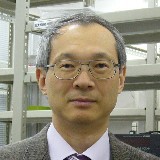
| Name | Naohiro Hozumi |
|---|---|
| Affiliation | International Cooperation Center for Engineering Education Development (ICCEED) |
| Title | Professor |
| Fields of Research | Measurement / Dielectrics / Ultrasonics |
ここでコンテンツ終わりです。

